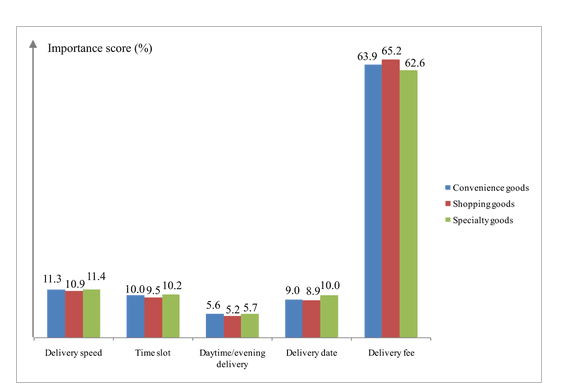There has been quite a bit of survey work from consulting firms, logistics providers and others on what consumer value in terms of ecommerce delivery.
Though most of us don't see it, there is also a growing body of academic research on the subject as well.
Still, four European academics – Dung Nguyen (VU University in Amsterdam),
Sander de Leeuw (also of VU), Wout Dullaert (Nottingham Trent University), and Bram Foubert (Maastricht University) – recently wrote a paper in CSCMP's Journal of Business Logistics noting that there has been a lack of prior research on consumer evaluations of delivery attributes in online retailing and the importance of understanding this for online retailers.
Supply Chain Digest Says... |
|
|
So, their research and recent paper were produced to answer the following main research questions: (1) How do online shoppers value and trade off delivery attributes when selecting a delivery option? and (2) do these evaluations and trade‐offs vary across product categories or consumer segments?
That sounds interesting.
Without getting too technical, the authors introduce early in the paper the concept of "mental accounting," which they say is key to how consumers evaluate different delivery options.
Mental accounting, they say, involves individuals categorizing their activities into mental accounts and making purchase decisions based on the allocated resources of their budgets for each of the mental accounts instead of integrating all the decisions to optimize their consumption.
What's more, context of course matters in this mental accounting for efulfillment options. For example, if a very expensive product is needed quickly, consumers may find it less problematic to spend more on delivery fees thanthey would for lower value goods.
The authors considered a number of potential variables a consumer might consider. Those are:
Delivery time slot, defined as the time interval in which online consumers receive their delivery - and therefore represents the time consumers must be present at a location to receive the delivery.
Daytime/evening delivery allows consumers to choose the part of the day during which the product will be delivered. It is basically a special time slot (daytime: from 9 a.m. to 5 p.m.; evening: 6 to 10 p.m.) that is increasingly offered by online retailers.
Selecting the delivery date, an attribute that research has found to contribute to consumer satisfaction in online retailing.
The delivery fee, which involves a crucial attribute with a clear impact on consumer behavior Typically, online retailers charge higher fees for less flexible delivery options. Often, they offer a premium delivery service in addition to standard ones.
Delivery speed, measured by the lead time between a consumer placing an online order and receiving the order. Online consumers increasingly want shorter lead times such that online retailers face a "last mile" challenge with increasing delivery costs. ,
As part of the project the team used a Dutch market research firm, which was able to get valid surveys completed by just over 1000 Euro consumers, with a wide distribution across different age brackets, male and female, etc. Also, questions were altered for different respondents to reflect three different types of products: convenience goods, shopping goods, and specialty goods.
As shown in the chart below, and consistent with other research on the topic we have seen, delivery fees or costs dominate in terms of importance, regardless of the type of good being ordered. Delivery speed was a distant number 2.
Cost Dominates Consumer Preferences for eFulfillment

The research then looks at different mixes of the key attributes.
.(See More Below)
|
CATEGORY SPONSOR: SOFTEON |
|
|
| |
|
|
The authors say the analysis shows the most preferable combination for consumers is to have free delivery, delivery from Monday to Saturday, delivery during daytime and in the evening, delivery within a time slot of 2 hours, and same‐day delivery. In other words, they really want it all.
In line with initial expectations, the research also found that a consumer's preference for a delivery option decreases with an increase in delivery fee.
Ok, no surprise with any of that.
A bit more interesting was a simulation exercise that identified three types or clusters of consumers within the category of convenience goods:
Price Oriented: For this cluster, delivery fee is by far the most important delivery attribute and is much more important than in the other clusters.
Time‐ and convenience‐oriented: For this cluster, delivery fee is still the most important attribute but it is far less important (41%) than in the other two segments. The non-price attributes, delivery speed, time slot, daytime/evening delivery, and delivery date, collectively are more important than delivery fee.
Value‐for‐money‐oriented: With this cluster, consumers in this segment care more about price than those in Cluster 2 but also care more about speed, time slot, and moment of delivery than those in Cluster 1.
Clusters were very similar for other two types of goods, the research found.
The upshot of this may be opportunities for etailers to segment customers along these clusters. From a marketing perspective, this is especially true because the research found that that these segments share demographic characteristics, including gender and income.
"More specifically, the "price‐oriented" segment mainly consists of female and low‐ to middle‐income consumers," the authors write. "The "time‐ and convenience‐oriented" segment mainly consists of male and middle‐ to high‐income consumers. The "value‐for‐money‐oriented" segment has a less outspoken profile that hovers between that of the price‐oriented and that of the convenience‐oriented segment."
The bottom line: Low cost or free delivery of course tops the consumer preference list, by a substantial margin, but offerings with more trade-off options might appeal to other segments of the market
Any reactions to this ecommerce research? Is segmentation possible? Let us know your thoughts at the Feedback section below.
Your Comments/Feedback
|